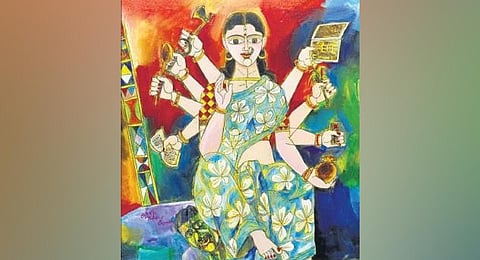

HYDERABAD: City-based artists share their expressions of the festivals of Navratri, Dussehra and Durga Pujo. From representing womanhood in the form of divine spirituality to celebrating novelty and freshness, these paintings exhibit joy and gaiety in traditional and modern versions alike.
As Navratri approaches, the air is filled with the sound of festivities again. While the Western world considers the ‘fall’ to be a season of waning, which brings melancholy and approaching winter, India, celebrates this period with auspiciousness, with gaiety and fervour. Celebrated in the month of Ashwin as per the Hindu calendar, Navratri, meaning nine nights and ten days comprises a diversity of rituals and customs. It is associated with colours, vibrancy, unity and joy.
Durga Pujo celebrations are also abundant with the setting up of pandals. Goddess Durga is celebrated as the form of shakti or power and each day of the Navratri represents the nine avatars of Goddess Durga. The tenth day is celebrated as ‘Vijayadashmi’ also known as Dussehra. The practice of Ayudha Puja is also observed on this day.
Artistry and creativity are the essence of this festival as a lot of attention is paid to decorations. Homes and temples are adorned with flowers, lights and colourful rangoli designs. The goddess is depicted in various forms and idols and blessings are sought from gods and elders alike. Navratri is a festival that blends devotion, cultural diversity, and artistic expression. It is a celebration of the divine feminine and the triumph of good over evil.
Talking of artistic expression, city-based artists leave no stone unturned in documenting this festivity on their canvases. It is absolutely impossible to be surrounded by the loudness of colours and escape it entirely. We ask a few of them to share their expressions of these festivals with us.
Laxman Aaley’s ‘Mother Goddess’ is a 48X36-inch, acrylic on canvas. A woman, while playing multiple roles, brings in vibrancy, fertility, power and compassion; and triumphs over evil and all human vices. Presenting a common woman adorned in a saree with white, five-petaled flowers and sitting on the left shoulder of a man, Laxman showcases the power and rock-solid permanency of feminine energy. The vibrancy of colours diffusing into the background, earthy colours of blue, green and brown bring about the lightness of Aaley’s woman, her tenderness and yet with a kind of strength represented by her large frame in the picture.
Kishan Kappari, a senior artist and art teacher from Jawahar Bal Bhawan, Public Gardens says, “I do my paintings on the Indian festivals of Ganesh Chaturthi and Dussehra because it is a part of my childhood memories to celebrate these festivals. We observe fast for nine days during Navratri. I participate in the Durga Pujo festivities, from setting up the mandaps to attending evening bhajan sessions. Joy and energy that is involved in the celebration of these festivals come out on my canvas. I paint one picture each day of the Navratri.
The theme of the triumph of good over evil is displayed in simple colours. Also, there is freshness in each of these festivals because we wear new clothes, pick out fresh flowers for puja, and make fresh food — I try to bring that forth as well. Small things such as offering jammi akku to the elders and motifs taken from Ayudha Puja also feature my paintings.” His 10X7-inch watercolour painting ‘Vijayadashami’ comprises all these elements to present the essence of Dussehra on canvas.
Bolgum Nagesh Goud, in his modernistic versions of goddess Parvathi, presents ‘Aadhi Shakti’ and ‘Ardhanaareshwara.’ The beauty of both paintings is the way contrasting colours are used with perfect precision and geometrical symmetry. ‘Aadhi Shakti’ showcases the goddess’s large face in dark colours with a red forehead, symbolising power and fertility. On the face, there are lords Ganesha and Siddhibuddhi on either side. In Ardhanaareshwara, half side displays lord Shiva and the other half portrays the goddess Parvathi. The acrylic painting is adorned with fine, minute and intricate Mandala art done with paper and ink.
Maredu Ramu also showcases a woman with a red bindi but the image is tarnished as ten Ravana heads surround her with malicious gaze. In the right middle of the painting, there is Lord Hanuman sitting and worshipping the woman. While on one hand the beautiful image of a woman is shown as equal to a goddess, on the other, it is blotted and torn as it is surrounded by the Ravana heads, full of vices.
The inescapable spirit of these festivals fills the canvases of these talented artists with colours, vibrancy and joy such that the gods and goddesses themselves seem to be descending down in these expressions and adorning these colours.